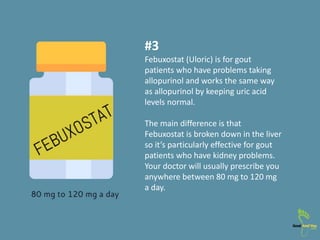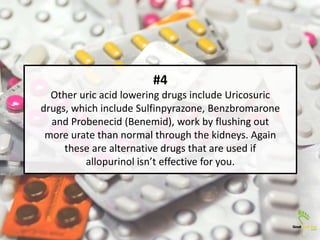Gout Treatments
- 1. GOUT TREATMENTS WHAT ARE YOUR OPTIONS TO TREAT GOUT?
- 2. So youâve suffered a gout attack and now you want to learn what to do to stop it or you have been suffering from gout and want to know all of your options that are available to treat the high uric acid levels so you avoid another painful gout attack. Well the gout treatments that are available to you are as follows:
- 3. #1 Use a cold pack of ice or cold compresses and put it on your affected joint for about 20 to 30 minutes. This will lower the inflammation and lessen the pain. Repeat as often as you like. Treatments and medications to prevent future gout attacks
- 4. If you are going to walk try and use a cane for some support. #2 Rest the affected joint. Donât put too much weight on it. If itâs on the toe or foot area, avoid walking, this will speed up your recovery.
- 5. Other similar types include Sulindac (Clinoril), Celecoxib (Celebrex), or Meloxicam (Mobic) #3 Take 800 mg Ibuprofen (Advil or Motrin) three or four times daily. You can also take 25 to 50 mg of Indomethacin (Indocin) four times daily to relieve symptoms and stop treatment after pain has been resolved.
- 6. #4 Drink a lot of water while suffering from an attack at least 12 glasses in a day in order to stabilize uric acid levels to a normal level. Some folks will add apple cider vinegar or even baking soda in water to lower uric acid levels a little quicker. Other gout patients have also experienced pain relief by eating a lot of cherries.
- 7. #5 Watch what you eat since you are at a very sensitive point. Try and eat no meat and make sure to not drink any alcoholic beverage and no foods or beverages high in sugar.
- 8. #6 If you visit a doctor, most likely he will treat you with NSAIDs like corticosteroids which will either be injected in the affected joint or given for you to take orally to get rid of the pain.
- 9. #7 A doctorâs most effective choice will be colchicine (Colcrys) which can be given in combination with NSAIDs. Colchicine can do the job in getting rid of your gout pain within a few days. The recommended dose is about 0.5 mg two to four times a day depending on your age, weight and health. Itâs very important your doctor starts you off with a low dose to see how you react to it and only then increase it higher.
- 10. #1 Again your doctor may prescribe colchicine for you for life to keep uric acid levels in check. Treatments and medications to prevent future gout attacks
- 11. #2 The most popular prescribed drug for preventing gout attacks and keeping uric acid levels in the normal range is allopurinol (Lopurin, Zyloprim). It takes about two to three months to become effective and you need to take it everyday usually for the remainder of your life. When you first take allopurinol, it can sometimes cause you a gout attack. This is because it may cause the level of uric acid to rise slightly before it falls.
- 12. Your doctor will prescribe you this if you have suffered from two or more attacks within a year, suffer from tophi, joint or kidney damage due to gout or kidney stones. Your doctor will usually prescribe you anywhere between 100 mg to 300 mg a day. Youâll need to take repeated blood tests every year to make sure your urate level is low.
- 13. #3 Febuxostat (Uloric) is for gout patients who have problems taking allopurinol and works the same way as allopurinol by keeping uric acid levels normal. The main difference is that Febuxostat is broken down in the liver so itâs particularly effective for gout patients who have kidney problems. Your doctor will usually prescribe you anywhere between 80 mg to 120 mg a day.
- 14. #4 Other uric acid lowering drugs include Uricosuric drugs, which include Sulfinpyrazone, Benzbromarone and Probenecid (Benemid), work by flushing out more urate than normal through the kidneys. Again these are alternative drugs that are used if allopurinol isnât effective for you.
- 15. #5 There is a new kid on the block called Pegloticase approved by the FDA in 2010 which lowers uric acid levels and is injected into a vein every two weeks. For now this drug is only used for severe cases which havenât improved with any of the standard treatments mentioned above.
- 16. #6 A 2009 study showed that vitamin C can help you keep uric acid levels lower and reduce the risk of developing gout. In the study those subjects that took 1500 mg of vitamin C a day experienced a 45% lower risk of gout compared to subjects who only took 250 mg in a day.
- 17. Donât forget about lifestyle changes once you are diagnosed with gout. They are just as important as the medication prescribed to you if not even more important to make sure your condition doesnât worsen.
- 18. A diet rich in complex carbohydrates that includes fresh fruits, vegetables, whole wheat breads and pastas and whole grain rices should consist of the majority of your daily calories.
- 19. Whereas fats like milk, cheese, butter and eggs as well as protein like meats, fish and poultry should be limited to 10% of each (20% both) of your daily caloric intake for optimal uric acid levels.
- 20. FIND OUT MORE LEARN MORE ABOUT THE DIFFERENT GOUT TREATMENTS CLICK HERE




















